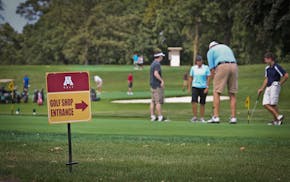RURAL ALBANY, MINN. - Down a dirt road this week, past the cattle wading in the creek, and up next to a grey barn, a white cow with brown spots calmly submitted to her gussying-up on the eve of a trip down to the Minnesota State Fair.
Isabella "Bella" Schiffler, who will be a junior this fall at Albany High School, along with her older sister, Sophia, expertly ran hair clippers over the champion cow's wide belly, as flecks of fur fell to the ground.
"If it's a cow, you look at their udder the most," Bella said, explaining judging criteria by pointing to a red-and-white Holstein, who stared demurely back. "You want it full, with lots of venation."
Against odds that have upended the dairy community, Bella is bringing cows, including a brown Swiss named Dangerous, to the Minnesota State Fair, which opens Thursday.
Earlier this year, U.S. Department of Agriculture researchers found H5N1, better known as bird flu, had jumped into a cow in Texas. Since then, the virus has been documented in hundreds of dairy herds across the country, including nine herds in Minnesota, comprising 8,000 cattle. And many farmers aren't testing.
The disease isn't deadly in cows, and human impact is incredibly rare; the milk of infected cattle remains safe to drink as long as it's pasteurized. But the virus can dramatically slow down milk production for a month or more, upending finances for a dairy community already racked by low milk prices.
The fair exists to promote agriculture, with animal shows the heartbeat of this tradition. And the battle against infectious disease has raised specters of the past: In 2009, swine flu sent more than 100 4-H kids home early from Falcon Heights after four teens contracted the H1N1 virus. The bird flu of 2015 led to the cancellation of the poultry shows.
This year, Minnesota's dairy families had difficult decisions to make. Some of the state's leading veterinarians, including Dr. Joe Armstrong at the University of Minnesota Extension, sounded the alarm earlier this summer, asking for a closure to exhibitions.
Fairs, he argued, offered a perfect stew — lots of farm animals, lots of people — to spread wide a virus that has been a killer for Minnesota's nation-leading commercial poultry barns.
"That's the problem with the attitude right now is everyone is figuring out how to avoid testing," said Armstrong, who contributes to the podcast, Moos Room. "In reality, what we should be doing is figuring out how to solve the problem and control the virus."
Officials at the fair in Stearns County, Minnesota's largest dairy county with roughly 1 milk cow for each of its 160,000 residents, opted to go forward with dairy competitions.
For the Schifflers, who have five kids who show cows, "We just don't want to live in fear," said Kristie Schiffler, Bella's mom. She compared it to COVID, saying life on the farm remained pretty much the same, while the world was overturned.
So in late July, a week before the county fair, the Schifflers had their lactating show cows tested. Their veterinarian filled a small bottle with milk from each cow. When the tests returned negative, they loaded up the cows into trailers, and drove to the Stearns County Fairgrounds on the edge of Sauk Centre.
Across the barn, 4-H participants knew about bird flu moving through locals herds. Since July, three Minnesota turkey barns — including roughly 40,000 birds — have tested positive for bird flu.
"Poultry, they have to kill the barns off to get rid of [the virus]," said Tyler Ratka of Cold Spring, who just finished his freshman year at the U and was glad for a final summer of 4-H competition. "The big thing that dairy producers have seen is a big drop in milk production and spending lots of money on medications."
Ratka also noted that some pregnant cows have aborted calves, compounding the cost for producers.
Standing at the mouth of the show barn, Tom Peterson, who oversees the dairy competition in Stearns County, said he was surprised by how many entries showed up.
"Personally, if it was me, and I was a dairy producer, there would be no way in hell that I would test a cow," said Peterson. "But I also don't have kids that are trying to get to the State Fair. So it's a calculated risk."
On the August day, the temperature topped 90 degrees. 4-H kids lined up their cows, some taking last-minute baby wipes to their animals' nostrils. The judge spoke over the blowing of large fans.
"The winning winter calf, a calf so balanced all the way and throughout, so square-made," said the judge. Regarding a heifer, she noted, "you really admire for her overall width."
A week after the fair concluded, Peterson said he hadn't heard about sick cows from participants.
The State Fair will mean more animals in stalls — and people. Among the potential 2 million visitors, many will swing through the animal barns to spy alpacas, rabbits, prize hogs and turkeys. It's one of the few moments the state's broad agriculture community comes literally face-to-face with the rest of Minnesota who may only know farm animals from children's picture books.
This past Tuesday afternoon, Bella made sure Dangerous would be ready, as she took a clippers to the cow. Inside the adjacent barn, robots milked the cows, an addition from 2020. Kristie doesn't know if any kids will take over the farm. But if so, they'd join a tradition in central Minnesota.
"Dairy, dairy, dairy," she said, pointing to the farms in the distance. "More dairy."
She knows there are fewer dairies each year on the landscape. They milk 250 cows on this farm, which is the same one her husband, John, grew up on. But she remains hopeful.
"We're the kind of family that doesn't stress," Kristie said, "until it happens."
The biggest task this Tuesday afternoon is getting Dangerous' coat trimmed. Then, the long drive the next morning with the other cows from Stearns County for the bright lights of the fair. There'll probably be more than a few parents back at home, waiting with fingers-crossed, that if their child doesn't bring home a ribbon, they — and their cow — at least return healthy.

Thompson found guilty of murder in car crash that killed 5 young women

University of Minnesota is putting its golf course up for sale
U proposes 7% cuts to academic programs, largest tuition hike in more than a decade

Jury reaches verdict in Derrick Thompson murder trial for crash that killed 5

